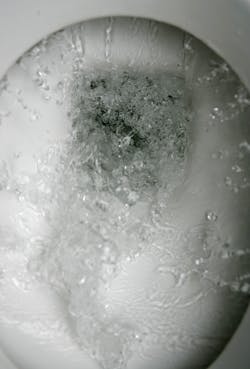WaterSense releases new specifications for water efficiency of Flushometers
WASHINGTON — With demands for performance improvement, energy efficiency and water savings, the Environmental Protection Agency’s WaterSense program has released new specifications for flushometer-valve toilets.
New rules call for rated flush volume of equal or less than 1.28 GPF, which the WaterSense Draft Specification for Flushometer-Valve Water Closets (Version 1.0) said is designed to ensure “sustainable, efficient water use and a high level of user satisfaction with flushing performance.” This will apply to toilets made from stainless steel, plastic and ceramic when tested. It is said to net a 20 percent savings over the standard 1.6 GPF toilets and a much greater savings from valves that use in excess of 4 gallons per flush.
The program has seen plenty of success since it started in 2006, as the EPA claims it has helped save more than $14 billion and 757 gallons of water.
WaterSense announces plans for flushometer valve specification
WaterSense chief details progress of flushometer, commercial bowl certification
The flushometer’s valve needs to maintain a flush volume with a variance of no more than 10 percent from the rated 1.28 GPF. Manufacturers must guarantee that valves are created so maintenance and replacement parts cannot make the device exceed this rated volume.
Flush performance testing will include crumbled toilet paper and an unfolded, unwaxed seat cover to make sure the valve has a flush volume adequate enough to take this material down the pipes. In a successful test, the standards say that, “No paper or seat cover shall remain in the well after each initial flush.” Sets of three tests will be done to ensure the proper measurement is attained.
If a flushometer valve has an above average flush volume, it will need to be adjusted prior to performance testing. The specifications do not mention what will happen if a test is failed or how many testing opportunities there will be.
As far as packaging and marketing is concerned, the standards specifically note that the flushometer valve cannot be marked, packaged or provided with instructions telling users how to achieve an alternative volume setting.
“Product documentation shall be clearly marked with specific maintenance or replacement part instructions and identification of correct replacement parts that should be used to ensure that the device will not exceed its rated flush volume,” the EPA said in the WaterSense Flushometer Standards. “Under no circumstances can manufacturers provide maintenance instructions or advertise the use of any replacement parts that would cause the flushometer valve to exceed its rated flush volume.”
Any manufacturer abiding by these water-efficiency standards must include a WaterSense label on packaging and should also display the emblem on their websites. The effective date of the WaterSense flushometer standards is to be determined.
In April 2014, CONTRACTOR reported that WaterSense Lead Engineer Stephanie Tanner and EPA contractor Robert Pickering said there were about 11,000 products already carrying the WaterSense label. About a half-million of these valves are sold each year, with in excess of 26 million currently in use. Tanner said that if all of the valves in use were on the 1.28 GPF standards, it would save approximately 56 billion gallons of water.
Manufacturers looking to be part of these WaterSense standards should visit the EPA's website with questions or comments.
